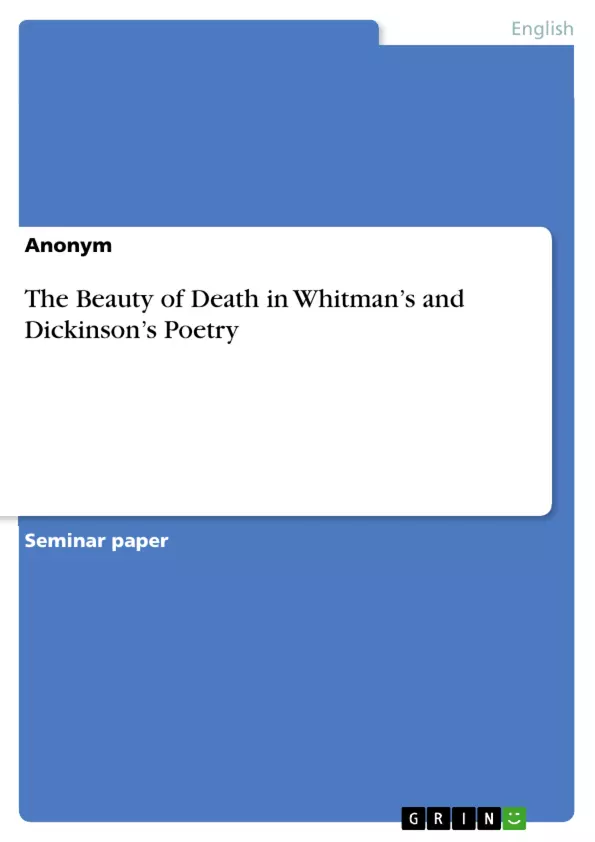This paper analyses these aspects of “beauty” in death within three poems by each author that are commonly associated with the topic; those are "Song of myself", "To Think of Time" and "As at thy Portals also Death" by Walt Whitman, as well as "I heard a fly buzz – when I died", "Because I could not stop for Death" and "I haven’t told my garden yet" by Emily Dickinson. This analysis then allows for a deeper insight into how these two writers make death beautiful in the conclusion.
Death is a topic that is discussed widely in all of poetry. Two very popular poets of 19th century America whose works often centered around the issue are Walt Whitman and Emily Dickinson. Though most of Dickinson’s poetry and large parts of Whitman’s Leaves of Grass deal with this common theme, their poetry is quite different in their writing styles, length, etc.
However, I would argue that both Whitman and Dickinson share a positive view on death, that is among other things depicted by the aesthetic language they use to describe the end of life as well as their belief in immortality or some sort of an afterlife, which is commonly associated with a “beautiful” experience when someone passes on.
Table of Contents
- Walt Whitman - Song of myself
- To think of Time
- As at thy Portals also Death
- Emily Dickinson - I heard a fly buzz – when I died
- Because I could not stop for Death
- I haven't told my garden yet
Objectives and Key Themes
This paper analyzes the concept of "beauty" in death within the works of Walt Whitman and Emily Dickinson, specifically focusing on three poems by each author. It examines how these poets use aesthetic language and their belief in immortality to present death as a positive experience. The paper aims to provide deeper insight into the unique ways these writers make death beautiful.
- The use of aesthetic language to describe death.
- The belief in immortality or an afterlife.
- The portrayal of death as a positive and transformative experience.
- The exploration of death as a natural part of life's cycle.
- The comparison and contrast of Whitman's and Dickinson's approaches to death.
Chapter Summaries
Walt Whitman - Song of myself
This poem expresses the lyrical subject's belief in an afterlife, using the term "somewhere" to describe the place where the deceased go. It explores the speaker's spirituality, suggesting a belief in a higher power that is embodied in all living things. The poem portrays death as a continuation of life, emphasizing the idea of rebirth and the cyclical nature of life and death. It explores the concept of the body decomposing and becoming fertilizer for new life, suggesting a connection between death and the renewal of life.
To think of Time
This poem explores the natural cycle of life, focusing on the persona's fascination with death and their desire to understand it. It presents a belief in immortality and explores the concept of death as a part of a larger, eternal cycle. The poem emphasizes the inevitability of death and encourages readers to embrace life fully, rather than fearing death.
Emily Dickinson - I heard a fly buzz – when I died
This poem describes the experience of dying, focusing on the sensory details and the emotional impact of the event. It explores the themes of acceptance and peace in the face of death. The poem uses vivid imagery to create a sense of finality and transcendence, suggesting the possibility of a spiritual transition.
Because I could not stop for Death
This poem personifies Death as a gentle and courteous companion, taking the speaker on a journey toward eternity. It explores the themes of mortality, eternity, and the acceptance of death. The poem's imagery suggests a peaceful transition from life to death, with a focus on the beauty of the afterlife.
I haven't told my garden yet
This poem explores the idea of preparing for death, focusing on the speaker's desire to communicate their final wishes to their loved ones. It touches upon the themes of love, loss, and the bittersweet nature of farewells. The poem uses a garden metaphor to suggest the importance of leaving a legacy and the enduring nature of love.
Keywords
The paper focuses on the themes of death and immortality in the poetry of Walt Whitman and Emily Dickinson. It explores the use of aesthetic language, spirituality, reincarnation, and the natural cycle of life as key concepts in understanding these poets' perspectives on death.
- Quote paper
- Anonym (Author), 2020, The Beauty of Death in Whitman’s and Dickinson’s Poetry, Munich, GRIN Verlag, https://www.grin.com/document/1377725



